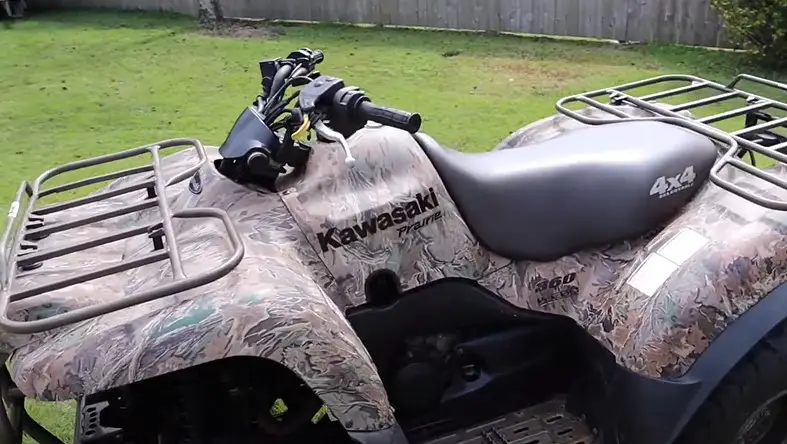Are you a proud owner of a Kawasaki Prairie 360? The tiny 4×4 utility ATV is popular among outdoor lovers due to its power and versatility. However, the Kawasaki Prairie 360 can encounter its fair share of issues, as any machine.
In this article, I’ll look at the most common issues identified by Kawasaki Prairie 360 users and offer expert advise on how to resolve them. Whether you are an experienced rider or new to ATVs, I will provide you with the information you need to keep your Kawasaki Prairie 360 working smoothly. So, if you’re ready to face the usual problems with the Kawasaki Prairie 360, let’s get started.
See More: Top10 Kawasaki KRX 1000 Problems And Solution
Basic Features of Kawasaki Prairie 360:
|
Feature |
Type/ Value |
|
TYPE |
Air-cooled, SOHC, four-stroke, single cylinder |
|
DISPLACEMENT |
362 cm3 |
|
BORE X STROKE |
3.1×2.8 in OR 79 mm |
|
COMPRESSION RATIO |
8.3:1 |
|
FUEL SYSTEM |
Keihin CVK34 Carburetor |
|
GEARBOX |
Automatic, L, H, reverse |
|
CLUTCH |
Automatic |
|
FINAL DRIVE |
Shaft, 4WD |
|
FRAME |
Steel double-cradle |
|
FRONT SUSPENSION |
MacPherson strut / 6.7 in. |
|
REAR SUSPENSION |
Swingarm with single shock, preload adjustment / 7.1 in. |
|
FRONT BRAKE |
Dual hydraulic discs |
|
REAR BRAKE |
Sealed, oil-bathed, multi-disc |
|
FRONT TIRE |
AT25x8-12 tubeless |
|
REAR TIRE |
AT25x10-12 tubeless |
Now, let’s move to the associated problems and their fixes.
The most common Kawasaki Prairie 360 problems include:
1. Starting Issues
Problem: Difficulty starting the ATV, especially when cold.
Solution: Check the battery for proper voltage and connections. Clean or tighten any loose connections. If the battery is old or weak, consider replacing it. Additionally, inspect the fuel system for any clogs or blockages that may prevent proper fuel flow to the engine.
2. Engine Performance Problems
Problem: Poor acceleration, stalling, or rough idling.
Solution: Start by checking the air filter for dirt or debris that may restrict airflow to the engine. Replace the air filter if necessary. Next, inspect the fuel system, including the fuel filter and carburetor, for any issues such as clogs or contamination. Clean or replace components as needed. Additionally, ensure that the spark plug is in good condition and properly gapped.
3. Electrical Issues
Problem: Malfunctioning lights, gauges, or other electrical components.
Solution: Begin by checking the ATV’s fuses to ensure they are not blown. Replace any blown fuses with ones of the same rating. Next, inspect the wiring harness for any frayed or damaged wires. Repair or replace any damaged wiring. Finally, check the ATV’s charging system to ensure the battery is receiving a proper charge from the alternator or stator.
See More: Kawasaki Bayou 220 Review Speed and Specifications
4. Transmission Problems
Problem: Difficulty shifting gears, grinding noises, or slipping.
Solution: First, check the transmission fluid level and condition. If the fluid is low or dirty, flush and replace it according to the manufacturer’s recommendations. Inspect the drive belt for signs of wear or damage and replace it if necessary. Additionally, check the clutch adjustment and linkage for proper operation.
5. Suspension and Steering Issues
Problem: Rough or unstable handling, excessive bouncing, or wandering.
Solution: Inspect the ATV’s suspension components, including shocks, springs, and bushings, for signs of wear or damage. Replace any worn or damaged components as needed. Next, check the ATV’s steering system for loose or worn parts, such as tie rods or ball joints. Tighten or replace any worn components to ensure proper steering control.
6. Low Performance in Cold Weather
Many Kawasaki Prairie 360 owners have stated that their vehicles run poorly in cold temperatures. Owners claimed that their machines would stall if they did not choke them for at least 5 minutes after starting, especially in colder climates.
The Prairie 360’s poor performance or cold start is caused by carburetor and pilot jet issues.
The carburetors can become clogged with debris and grease over time. Furthermore, improper carburetor maintenance has an impact on the pilot jets that are placed within them, potentially dislocating them.
Because the carburetor is not fed with appropriate fuel, the partial blocking of pilot jets in the vehicle can make the transition to operate at greater speeds easier.
Solution:
The solution to this problem is to completely clean the carburetor, especially the pilot jets.
First, remove the quad’s pilot jets, disassemble them, and thoroughly wash them to remove any debris and filth.
Remove the pilot jets from the carburetor, unplug them, and clean them using carb cleaner spray.
The cold starting troubles on the Kawasaki Prairie 360 are substantially remedied after thoroughly cleaning the carburetor and pilot jets.

